#historical significance india's independence
Explore tagged Tumblr posts
Text
Complete Analysis Of True Independence Day
On August 15, 1947, India gained independence from British rule, but it remained a dominion within the British Commonwealth. King George VI continued as the head of state until India became a republic on January 26, 1950. The dominion status meant that India's independence was not entirely free from external influence. August 15, 1947, was a Compromise.
#true independence#subhas chandra bose#azad hind government#andaman and nicobar#political sovereignty#1943 declaration#genuine freedom#historical significance india's independence#december 30#1943
0 notes
Text

"Happy Independence Day"#trending#viral
The Happy Independence Day Importance goes beyond just celebrating a national holiday; it's a day that marks the sacrifices, struggles, and triumphs of countless heroes who fought for India's freedom. In this we'll delve into why Independence Day holds such profound significance in the hearts of every Indian. From the historical context to the contemporary relevance, we explore how this day is a reminder of the responsibilities and duties we carry as citizens of a free nation. Whether you’re reflecting on the past or looking towards the future, understanding the true meaning of Independence Day can inspire a deeper sense of patriotism and pride. Join us as we uncover the hidden layers of this important day and celebrate it with the respect and honor it deserves.
Call : 7799799221
Website : www.manasadefenceacademy.com
#IndependenceDay#Freedom#Patriotism#India#NationalPride#IndianHistory#IndependenceDay2024#FreedomFighters#IndianCulture#HappyIndependenceDay#trending#viral#manasadefenceacademy
#Happy Independence Day Importance#Independence Day significance#why is Independence Day important#India Independence Day#why celebrate Independence Day#Independence Day meaning#historical importance of Independence Day#Indian freedom struggle#Independence Day relevance#celebrating Independence Day#national holiday India#Indian patriotism#importance of Independence Day#Independence Day 2024#India national pride#freedom fighters#Indian history#Independence Day speech#meaning of Independence Day#what is Independence Day#why India celebrates Independence Day#Independence Day for kids#Independence Day facts#Independence Day essay#why Independence Day matters#Indian culture#Independence Day celebrations#15th August importance#August 15 India#Independence Day true meaning
3 notes
·
View notes
Text
A Melody In Mysore by Shruthi Rao - shows significance of gramophone records in the freedom movement
A Melody in Mysore is an inspiring and heartwarming historical fiction that highlights the impact and significance of gramophone records in the freedom movement, as well as the quiet courage and unity of those who fought for the nation’s freedom. A Melody In Mysore – shows significance of gramophone records in the freedom movementSynopsisReviewBook Links A Melody In Mysore by Shruthi…
#A Melody in Mysore#book blog feature#Book review#book review blog#Book review feature#Books set around independent India#Books Teacup and Reviews#Historical Fiction#Indian Book Blogger#Middle Grade#Penguin books#Shruthi Rao#significance of gramophone records in the freedom movement#Songs of Freedom series
0 notes
Text
77 Years of India's Independence : Learn about the important dates that define India's history as a vibrant democracy, a growing economy, and a nation that continues to evolve on the global stage.
#Independent India#India's Independence#Historical Movement#Important Dates#Indian History#India’s Independence#significant milestones#India's history#growing economy#key dates of India#After independence#india after independence#Indian independence day#Independence day of india#The Junior Age
0 notes
Photo

Khajuraho
Khajuraho was an ancient city in the Madhya Pradesh region of northern India. From the 10th to 12th century CE it was the capital of the Chandella kings who ruled Bundelkhand. Despite Khajuraho's once great reputation as an important cultural centre there are no surviving non-religious buildings, but the presence of 35 Hindu and Jain temples make it one of the most significant historical sites in India today and worthy of its name given by the 11th century CE Muslim historian Abu Rihan Alberuni as 'the City of the Gods'. Khajuraho is listed by UNESCO as a World Heritage Site.
Architectural Highlights
Most of the temples at Khajuraho were built using sandstone but four also used granite in their construction. In the latter group is the Chaunsat Yogini (64 tantric goddesses), built c. 875-900 CE, which has 64 shrine rooms arranged around a rectangular courtyard. Next in the site's development came the Lalguan Mahadeva, Brahma, and Matangesvara temples which are all quite plain in design and decoration compared to the later temples.
The majority of temples at Khajuraho were constructed between 950 and 1050 CE and are either Hindu (Saiva or Vaisnava) or Jain. The most famous is the Kandariya Mahadeo built in the early 11th century CE and dedicated to Shiva. The more or less contemporary Laksmana temple was built in 954 CE by King Dhanga (r. 950-999 CE) to celebrate independence from the Gurjara-Pratihara rulers and has a similar layout and exterior to the Kandariya Mahadeo. So too does the Visvanatha temple (c. 1002 CE) which was designed by Sutradhara Chhichchha. Both temples have shrines at each corner of their terrace platforms. The Laksmana was dedicated to Vishnu and its terrace is of particular note as it carries a narrative frieze running around all four sides: Elephants, warriors, hunters, and musicians form a procession watched by a ruler and his female attendants.
Other notable temples at the site include the single-towered Caturbhuja and Vamana, the squat Matulunga, and the rectangular, more austere Parshvanatha Jain temple with its unique shrine added to the rear of the building (c. 950-970 CE). Probably the latest temple at Khajuraho is the Duladeo which was built on a star-plan.
Continue reading...
61 notes
·
View notes
Text
Main lore of Encounters in the Frontier
In this pinned post I will introduce the main historical chronology and concepts of the setting.
Most of the events take place in a subcontinent with the general size, shape and latitude of India, wich is a penninsula of a larger megacontinent wich occupies most of the northern hemisphere. This subcontinent, wich I will just call the penninsula, has a shallow sea to the east, another to the west, steppe and large mountains to the north and a deep and vast ocean to the south, wich eventually leads to the land of alwaysummer. At the eastern sea are the twisted islands. The penninsula has dense forests to the northeast, jungles to the southeast and the western coast is more dry and desserted. the northwest has the plateau, a large elevated plains regions, spotted with forests and the centre of the continent is hilly and mountainous.
The Sun Empire had a humble origin as a city state in the southeast wich fought for its independence and won against a nomadic invador from the north. The years of foreign control made them realize their vulnerability and they began to rapidly militarize. For the Sun Empire, the best deffense was a good offense and they rapidly annexed the nearests city states in a rapid expansion. In their culture, war justified itself. They generally arrived at a city and offered them to surrender in good terms or be suffer very bad taxations and treatment after their defeat. Many chose the first option. At this time, certain warrior families began to rise to power and formed a warrior class wich selected a military leader from among themselves. There was also a very powerfull priest class, wich ended up concentrating into a single dynasty and also chose a leader from among themselves (Although the role ended up being inherited mostly). These two roles complimented each other. The military leader managed external politics and the executive power, while the priest leader managed internal politics and the juditial and legislative power, as well as of course, managing religious festivities and such. These two roles were imagined as being a husband and a wife (the priest leader was often a woman, since politics is considered a woman's job), the state a family and their population their children.The Empire spread westwards and managed to control one of the richest cities of the penninsula, Odras. This city lays under the plateau and is a hub from inland commerce and connects the trade routes of the eastern and western seas. They retained their religion and strong identity, wich had significant influence on the rest of the Sun Empire. By this time the Sun Empire's religion was politheistic with the sun god as the head of the pantheon.
By this time the Empire controlled many religions and peoples, in some cases loosely, and revolts had to be almost constantly supressed in the western and southern provinces. The central mountain range, southwestern dessert, northwestern plateau and norterns steppe were their most unstable frontiers, as well as eastern pirates from the Twisted Islands.
Now I will introduce the Twisted Islands and the magic system of the setting:
If you have ever been introduced to the concept of the fourth dimension or wormholes it was probably by the folded paper pierced by a pencil analogy.

This setting's shape is more like this:

Some parts of the world seem to be closer in the 4D plane than others, and wormholes are more likely to appear between them. Some regions have deeper folds and portals will be more common, while others are "flatter" and there will be almost no chance of one appearing. In this world, the Twisted Islands have the most and deepests "folds", so portals appear often, sometimes on their own and connect to many places.
The Twisted Islands are an archipellago of mostly very small atolls and poor in natural resources (except fish and shellfish I guess). Still, the portal's influence in the region is very apparent to the naked eye. Rock formations take impossible shapes, caves are larger than the cliff that contains them, trees grow upside down… so they attracted many sea peoples, wich settled in them for religious reasons. The islands often only held a small population of ascetic monks, wich sustained themselves with donations from pilgrims, wich mainly came from larger, less portal-active islands and lands, wich is where most of the Twisted Island's population is originally from, it's rare for people to be born in the islands proper.
Portals don't usually open on their own, and require energy input, such as a strong fire. Monks would place an offer over the fire, raise the temperature and the offer woud suddenly disappear with a flash of light, and sometimes something else would appear on its place (most often just rocks that don't match those of the island, but enough to impress anyone that sees it). Slowly, their methods became more refined and they could locate, open and predict where an object would go more reliably. The peoples of the Twisted Islands were also known as great sailors, good at sea trading and wich could venture into the open sea, while those from the Empire only sailed next to the shoreline.
Managing portals was a dangerous task, reserved only for the elite of the monasteries, trained for years. It could result in untreatable portal wounds, in wich a limb mantains it's function but becomes "twisted". This modified limb seemed useful in locating portals and their shape and angle, so some monks started modifying themselves on purpose, thought this is shunned by most.



Ok, so those were the basis of most regions before the Dragon Age, a period of ecological and political change. It started with the explosion of a megavolvano in a distant, unknown land, wich caused a volcanic night in the penninsula. This resulted in a widespread famine through the continent… then came the dragons



Dragons were probably native to the land were the volcano exploded and came looking for a new home. They eated cattle, wild megafauna and tragically often humans at an unsustainable rate. They mainly settled in the central mountain ranges of the penninsula and the northern steppe, wich caused mass migration from these lands. These migrations were often violent and caused great damage to the already in crisis Empire.
The first encounter with a dragon happened in a frontier fortress south of the plateau, wich was taken by a dragon at night and its inhabitants devoured. The dragon took the fortress as a nest to lay eggs. The Empire, after comunication with the fortress was cut, asumed it had been taken by a plateau tribe and sent a small platoon of soldiers to retake it (dragons were only a rumor atp). The whole platoon was massacred by the dragon.
At the north, the nomads united under a charismatic ruler called Saljar, wich conquered a big chunk of the Empire's land. In an almost suicide mission, the already desperate and decaying Empire went all in against this king from the north. This campaign was full of tensions and during their travel north, guerilla attacks from rebellious regions and dragons weakened both armies. The unpopular military ruler died right before battle (most likely secretly poisoned by the Ashiva, the priest ruler as the military leader was the one that made the bad desition of starting this campaign) and it seemed like all hope was lost, but Ashiva, took control and led the army into battle (a very desperatel move). During the battle two dragons started fighting eachother while flying on top of them and fell mid fight on top of the nomad troops, causing them to break formation and flee. Its said that Ashiva himself killed the feared Saljar. Ashiva became very popular and took supreme control of the Empire, claiming to be the Sun God personified.
Still, the Empire had many problems to adress, such as the dragons (all military efforts to hunt them ended in disaster) and the former army of Saljar, now dispersed in small armies, wich sacked the Empire's towns. Ashiva, proving to be a very capable diplomat, managed to organize a meeting with these warbands, where he recalled the fight of the dragons over their own armies, and claimed that, in the same way that these beast both died while fighting, so would they if they don't adress the dragons. Ashiva proposed that these war bands start to hunt the dragons and bring their heads to him, in exchange, the Empire would grant them power over their lands. The nomadic light camelry proved to be very effective at hunting dragons and they soon became powerful noble families and settled mainly in the frontier lands or rebellious regions of the Empire to "pacify them" (It's known that the natives of these regions considered their new rulers worse than the dragons).
It took about 120 years to hunt most dragons and end the dragon age. During this time the Empire was ruled by Ashiva's divine and absolute dynasty. The new Dragon Nobility became increasingly powerful and the danger of a coup d'etat was very real. The plateau and northern coast of Alwaysummer were conquered during this period.
During the mid Dragon Age, the most powerful monastery of the twisted islands learned how to reliably send objects through portals (if a living creatures is sent through a portal ir appears dead on the other side). The chief of that monastery sent a message through the portals to every other monastery of the archipellago, calling them for a meeting to show them how to do it. This meeting was known as The Call. The comercial use of the portals was immediatly exploited and the twisted islands unify and become the major hub of trade of this world. Diplomatic trips from the archipellago reached many distant lands to set portal openings and trade centers (the envoys were met with varied reactions, sometimes welcomed, rejected, or straight up killed). These portals were specially useful for sending messages and the rivalry between the Empire and the Islands only increased from now.
#fantasy worldbuilding#spec evo#worldbuilding#art#concept art#lore#oc lore#alt history#encounters in the frontier#dragon#fantasy#fantasy art
15 notes
·
View notes
Text
Reviving the Legacy of Waqf: A Forgotten Pillar of The Islamic Economy

In Islamic history, the waqf (plural: awqaf) represents a tradition that underpinned the development of Muslim societies. A practice rooted in faith and generosity, waqf was a system of endowments that provided cradle-to-grave support for communities, funding hospitals, schools, mosques, and even public infrastructure. Today, there is a renewed call to revive this practice, after it’s demise during the colonisation of Muslim lands, not only to sustain the Muslim community but to empower it to tackle modern challenges strategically.
The Concept of Waqf: A Gift for Eternity
At its core, waqf refers to the restriction of an asset for perpetual charitable use. Once designated as waqf, ownership of the asset is transferred to Allah, and its benefits are dedicated to the community. Unlike other forms of charity, such as zakat or sadaqah, waqf assets remain preserved, continuously generating benefits for specified causes. For instance, a piece of land could be endowed as a waqf to fund education, with rental income supporting schools indefinitely.
This system offers a unique form of sustainability, ensuring that the initial act of giving continues to yield rewards and benefits long after the donor’s lifetime. As the Prophet Muhammad (peace be upon him) said, “When a person dies, their deeds come to an end except for three: ongoing charity, beneficial knowledge, and a righteous child who prays for them.” Waqf embodies this concept of ongoing charity.
Historical Significance of Waqf
The origins of waqf trace back to the Prophet’s time. One of the earliest examples is the endowment of a date orchard by a Companion, Abu Talhah, after the Quranic verse, “You will not attain righteousness until you spend from what you love” (3:92). The Prophet advised him to dedicate the orchard as a waqf, benefiting his family and the broader community, even today.
Over the centuries, awqaf played a critical role in Islamic civilisation. Universities like Al-Qarawiyyin and Al-Azhar, renowned as the oldest in the world, were funded through waqf. In the Ottoman era, the system became so robust that it supported individuals from birth to death. Hospitals, schools, mosques, and even coffins were funded through awqaf, showcasing its comprehensive impact.
Ibn Battuta, the famed traveler, marvelled at the diversity of awqaf during his visits to Damascus, where endowments funded everything from animal care to bridal jewellery for underprivileged women. Such was the creativity and scope of waqf that it became a model emulated by Western institutions like Oxford University, which built its endowment structure inspired by Islamic waqf practices.
The Decline During Colonialism
The systematic dismantling of waqf institutions began during colonial rule in the 18th and 19th centuries. Colonial powers recognized the financial independence and societal cohesion that awqaf provided to Muslim communities and sought to centralise control. In India, for instance, the British enacted the Waqf Act of 1861, seizing control of waqf boards and redirecting funds for colonial purposes. Similar strategies were employed in Algeria and other regions, leading to the decline of waqf and its institutions.
This loss of autonomy marked the beginning of a dependency on centralised state systems for services once provided by waqf. The transition undermined the sustainability and empowerment that the decentralised waqf system offered which catered to local needs and provided for those in need despite weak, oppressive or ineffectual governments.
Reviving Waqf in Modern Contexts
Today, organisations like the National Waqf are working to revive this forgotten tradition. The vision is to reintroduce waqf as a means of sustainable financing for community development. Modern waqf structures focus on pooling donations to invest in income-generating assets, such as properties. The returns are then distributed to fund causes like education, healthcare, environmental initiatives, and political advocacy.
For example, a donated property can be rented out, with proceeds reinvested into the waqf and/or used to support community projects. This model ensures that even small contributions can create long-term impact. A single donation grows perpetually, multiplying its benefits over generations.
Strategic Giving for a Better Future
Reviving waqf is not just about sustaining existing institutions; it is about empowering communities. By strategically allocating funds, waqf can address systemic issues like poverty, education inequality, and even political advocacy. For instance, a dedicated waqf could fund legal initiatives to defend marginalised communities or support organisations lobbying for global justice.
A Call to Action
This is a call for Muslims to shift their mindset from short-term charity to long-term sustainability. By investing in waqf, donors ensure their contributions continue to grow, benefiting countless lives and leaving a lasting legacy.
The revival of waqf is not merely a return to tradition; it is a bold step toward empowering Muslim communities to thrive in the modern world. As we rebuild this forgotten pillar of Islamic civilisation, we unlock the potential to create a future that reflects the best of our faith and values.
For more about Islam visit: https://www.howtomuslim.org
Islamic Resources: https://www.howtomuslim.org/catalogue
Why Islam: https://www.howtomuslim.org/why-islam
Who was Prophet Muhammed (PBUH): https://www.howtomuslim.org/prophet-muhammed
9 notes
·
View notes
Text
Chagos islanders displaced for US military base marched to UK Parliament
Islanders who were forced to abandon their remote Indian Ocean home to make way for a US military base half a century ago protested outside Britain’s Parliament on Monday against a deal they say decided the fate of their homeland without them.
The British government announced last week that it was handing over the Chagos Islands to Mauritius under an agreement that would leave a US naval and bomber base on one of the islands, Diego Garcia.
Located south of the equator off the coast of India, the Chagos Islands have been under British rule since 1814. They became known as the British Indian Ocean Territory in 1965 when they were separated from Mauritius, a British colony that gained independence three years later.
Frankie Bontemps, a second-generation Chagos resident, remarked:
“Today they have a deal that suits them, best of course. But what about the people? What about the people they ignored 65 years ago? I feel, as I do, that history is repeating itself today.”
According to Yasmin Ahmed, director of Human Rights Watch UK, it is crucial for David Lammy, the British Foreign Secretary, Keir Starmer, the Prime Minister, and the whole government to recognise that they will not be able to right historical wrongs or meet their international obligations unless the Chagossian community is at the forefront of any agreements that allow them to return to their homeland and receive compensation.
Way for the US military base Diego Garcia
Britain expelled nearly 2,000 people from the islands in the 1960s and 1970s to make way for the US military base Diego Garcia, which supported military operations from Vietnam to Iraq and Afghanistan. In 2008, the US admitted that the base was also involved in secret rendition flights for terrorist suspects.
A significant number of islanders have resettled in the UK and unsuccessfully tried to reclaim their homeland through British legal channels. Their struggle has received global support, especially from African countries and the United Nations.
In a 2019 advisory opinion, the UN International Court of Justice ruled that Britain illegally partitioned Mauritius when it decided to end colonial rule in the late 1960s. The UN General Assembly has since passed a resolution calling on the UK to end its “colonial administration” of the Chagos Islands and return them to Mauritius.
Britain’s newly-elected Labour government says the military base status could be jeopardised by possible legal disputes if the deal is not finalised.
“British sovereignty over Gibraltar and the Falkland Islands is non-negotiable”
US President Joe Biden has welcomed the deal, saying it “ensures that the joint facility at Diego Garcia will operate effectively for the next century.” But Britain’s Conservative opposition said the decision to hand over part of the territory to the UK sets a worrying precedent for other vast possessions, including Gibraltar, claimed by Spain, and the Falkland Islands, claimed by Argentina.
The government strongly denies this. Starmer spokesman Dave Pares said on Monday that “British sovereignty over Gibraltar and the Falkland Islands is non-negotiable.”
The agreement would create a resettlement fund for displaced Chagos residents aimed at allowing them to return to the islands – with the exception of Diego Garcia. The UK says the details of any return are now the responsibility of Mauritius. Jamie Simon, whose grandparents were expelled from the Chagos islands, said:
“They shouldn’t have done this deal without asking us what we want. It may be just another island to them. It might just be a military base for them..But for us, it’s home.”
Read more HERE

#world news#news#world politics#europe#european news#uk#uk politics#uk news#chagos islands#chagossians#falkland islands#usa#usa news#usa politics#us politics#un#united nations
5 notes
·
View notes
Text


Silvia Federici’s Witches, Witch-Hunting, and Women is an important feminist intervention in the history of Western capitalism that exposes the continuum between historical and contemporary cultures of misogyny. The book is divided into two parts. Part one outlines the growing interest in re-examining European witch-hunting as the phenomenon ‘that paved the way for the modern capitalist world’ (p12). Part two applies the history of witch-hunting to present-day systemic violence against women. Federici explains how capitalism’s war against women began in the sixteenth century, the early Renaissance, with the enactment of enclosure laws that enabled the wholesale destruction of communal property relations. The witch hunts emerged as social elites – landowning gentry, the church, and upwardly mobile bourgeoisie – sought to disempower women and expropriate land by weaponizing Christian mythology to identify women as the potential embodiment of evil. Far from rational, science-lead development, Federici argues that the shift to modern capitalist society required new superstitions and new fears to be instilled in the populace. Accusations of witchcraft was a terror tactic designed to not only destroy women’s economic and sexual independence, but also their communal support networks and social contributions as healers, midwives, and merchants. Women, as a result, were victimised by systemic impoverishment and targeted for resisting the destruction of their communal-oriented being. The ramifications spanned economic and social spheres, rippling into the present. Interestingly, Federici even addresses the linguistic influence of the witch-hunts, including the effemininisation of ‘gossip’, a word that has evolved from its original meaning of female fellowship – to signify disparaging idle chatter.
In the second half of the book Federici reveals witch-hunting is not an isolated historical event: it constitutes a continuum into brutal new forms of violence against women spread by the growth of neoliberal globalisation. The worst atrocities are committed by contemporary patriarchies. They are tantamount to ‘feminicide’ and intensify at the cultural intersections of racism and capitalist economic restructuring. This manifests as disproportionately racialised murders of women in North America, a rise in ‘dowry murders’ in India, and the literal resurgence of witch-hunting among evangelists in multiple African nations. Federici’s argument is significant and far reaching, but in one instance it is diminished by her application of the label ‘Native American’ while referencing missing and murdered Indigenous women in Canada. This term is a colonial construct: the correct term, which should be adopted by scholars across Turtle Island, is ‘Indigenous’. Secondly, I would caution against assuming hypersexualised images of women are a source of violence against women, as women’s self-presentation as a sexual being is not the fundamental problem: the problem is rape-culture, and predatory masculine desire treating women’s bodies as a form of property. However, the strengths of this book far outweigh these criticisms. Not only does Federici detail women’s resistance to patriarchal oppression, she offers practical solutions to resolve the issues and hold governments, institutions, and movements accountable for the violence. For example, Federici questions why many feminists have not spoken out more loudly against contemporary witch-hunting practices in Africa. She blames a Western rational bias and a tendency towards political correctness that is loathe to portray non-White, non-Western cultures as irrational. As Federici demonstrates, irrationality has very little to do with the issue; the issue is expropriation masquerading as Christian righteousness. Federici’s work is uniquely constructive methodological critique of a truly radical cultural theorist.
By identifying the materialist roots of systemic gender crimes and injustices, Federici takes the long view of the feminist struggle and situates it outside of identity politics’ representational limitations. She recognises the intersecting injustices visited upon women by patriarchal societies intent on dispossessing women of their homes and community functions in the name of greed and insecurity. This was fostered in the past in the course of mercantile economies’ evolution into full blown capitalism during the early Renaissance and appears again as communities endure neoliberal economic restructuring programs. The social impoverishment of women is an ongoing battle. This book outlines not only the horrors of misogyny, but also present-day strategies of resistance. Most importantly, it offers solutions to contemporary cultural, social, and economic challenges women face at the intersections of capitalism, racism, and patriarchy.
#witchblr#Anarchist Studies#book review#feminism#patriarchy#witchcraft#autonomous zones#autonomy#anarchism#revolution#climate crisis#ecology#climate change#resistance#community building#practical anarchy#practical anarchism#anarchist society#practical#daily posts#communism#anti capitalist#anti capitalism#late stage capitalism#organization#grassroots#grass roots#anarchists#libraries#leftism
3 notes
·
View notes
Text

photographer Raghu Nayyar writes ...."The past couple of days, I spent my time in Amritsar, Punjab which happens to be a historically super significant place in India’s independence struggle against the Brits, a Mecca of the Sikhs and foodies paradise since majority of the North Indian dishes originate from here. Here is one photo of The Golden Temple, the most important religious site for the Sikhs. Apart from being a religious site, it also serves free, volunteer driven meals throughout the day and is the largest free kitchen in the world with over 100,000 delicious 3 course meals on a daily basis."
Amritsar, India
5 notes
·
View notes
Text
Rani Abbakka Chowta
Rani Abbakka Chowta, a key figure in Indian history, was part of the Chowta dynasty ruling coastal Karnataka. Known as Abhaya Rani for her bold nature, she emerged as an early freedom fighter against foreign invaders and colonial rule. As the queen of Ullal, Abbakka staunchly opposed Portuguese dominance, refusing tribute payments in 1555. Abbakka also challenged economic subjugation by the Portuguese, insisting on trade for the welfare of her people. Despite personal challenges, including a strained marriage, she prioritised her daughter's well-being, ultimately rescuing her daughter from an unwanted marriage proposal and resisting political alliances that compromised her principles. Abbakka's administration and army was inclusive, with individuals from diverse sects and castes. She formed strategic alliances with influential leaders to fortify her position against Portuguese incursions. Regarded as a significant threat by the Portuguese, Rani Abbakka stands as an early beacon of the Indian freedom movement. Her legacy endures through historical accounts and a bronze statue in Bengaluru, commemorating her unwavering defence of Ullal and her pivotal role in India's struggle for independence. Yet her story remains unknown, often overshadowed by the stories of other famous figures.
#Rani Abbakka Chowta#female freedom fighters#indian rulers#rani#women in history#india's fight for independence#colonialism#abbakka chowta#freedom fighters
11 notes
·
View notes
Text
"[T]he classical debate seems almost to attribute a secondary importance to the extraordinary historical significance of the active role of institutions in the late-joiner countries (signally in Germany) – initially in the forms of an accentuated centralization of the operations financing industrialization, and then, subsequently, with equipment intended to directly or indirectly govern the structure and composition of supply – when compared to the tendencies of the state-development relation, which is instead treated as essential. On the other hand, if a politics of fierce protections and then of imperialist expansion, which tends even to destroy the world market as simple area of exchange, corresponds to the anything but “parasitic” role of the state within second-comer industrialization, in this very phase the conditions, which had up to that point impeded the evolution of the international market from a mere moment of simple circulation to becoming the direct center of the accumulation process on a world scale, are changing radically. But concerning the whole process of internationalization, the classical debate performs a reading by all means conditioned by what has just been said.
The international movements of labor-power in this phase are events which largely remain to be studied. What is certain, however, is that they repeat on an enormous scale, though in different forms, the “originary” movements of the “slave trade” [tratta]: let it suffice to recall the massive extractions of labor-power from India and China, both towards other colonial areas (Africa) and to the metropolis, or to recall the waves of transoceanic immigration to the United States. If all this does not eliminate the existence of closed national markets of labor, still less is the relative international immobility of capital overcome by the waves of “capital export,” which the classical debate on imperialism rightly places at the center of its attention, and which constitute in fact the first massive historical phenomenon of “internationalization” of capital. In other words, this is still a hybrid form, so to speak, of transition, of the process of internationalization: this does not therefore represent a real qualitative leap of the system. As the recent literature on foreign investment has put into relief, this is dominated in this phase, quantitatively and qualitatively, by the figure of the investment “portfolio.” Although the nature of the latter cannot be made clear but in contrast to “direct” investment (a distinction that is not necessarily fully perceived in this moment), the phenomenon appears reconstructed, even then, in a substantially correct manner.
[...]
The adequate theoretical figure that encompasses [ricomprendere] the nature and dynamic of this specific mobility of capital is already totally developed in Marx: it involves capital as commodity – the loan capital market. In the 5th section of the third book Marx unfolds the general lines of his theory of this market, albeit in a rather fragmented manner:
On the money market it is only lenders and borrowers who face one another. The commodity has the same form, money. All particular forms of capital, arising from its investment in particular spheres of production or circulation, are obliterated here. It exists in the undifferentiated, self-identical form of independent value, of money. Competition between particular spheres now ceases; they are all thrown together as borrowers of money, and capital confronts them all in a form still indifferent to the specific manner and mode of its application. Here capital really does emerge, in the pressure of its demand and supply, as the common capital of the class, whereas industrial capital appears like this only in the movement and competition between particular spheres.
Whence the Marxian theory of the rate of interest and its critique of the existence of a “natural rate”:
As far as the permanently fluctuating market rate of interest is concerned, this is a fixed magnitude at any given moment, just like the market price of commodities, because on the money market all capital for loan confronts the functioning capital as an overall mass; i.e. the relationship between the supply of loan capital on the one hand, and the demand for it on the other, is what determines the market level of interest at any given time.
The rate of profit – which exists uniquely as a tendency, as a movement tending to equalize the particular rates of profit – constitutes only the external limit of the determination of the rate of interest, but the laws of formation of the one are in fact different from those of the other – their connection clearly resides only in the movement of the cycle. But the different nature of the two rates has a fundamental importance in this context, precisely for that aspect from which Marx’s analysis seems to want to abstract:
In stressing this distinction between the interest rate and the profit rate, we have so far left aside the following two factors, which favour the consolidation of the interest rate: (1) the historical pre-existence of interest-bearing capital and the existence of a general rate of interest handed down by tradition; (2) the far stronger direct influence that the world market exerts on the establishment of the interest rate, independently of the conditions of production in a country, as compared with its influence on the profit rate.
Exactly as the rate of interest historically anticipates the formation of the rate of profit, so it anticipates, at the level of the world market, the tendential movements of the rate of profit. The influence of the world market on the national rates of interest is in fact only an appearance [faccia] of the inverse process. Marx affirms this explicitly at the end of his analysis of credit:
The credit system hence accelerates the material development of the productive forces and the creation of the world market, which it is the historical task of the capitalist mode of production to bring to a certain level of development, as material foundations for the new form of production. At the same time, credit accelerates the violent outbreaks of this contradiction, crises, and with these the elements of dissolution of the old mode of production.
Capital export and the process of capitalist internationalization preceding the first world war are largely the practical realization of this anticipatory function of the movement of capital that is productive of interest. As such, they reproduce on a broad scale the characteristic ambivalence of this movement. The “classical” literature is aware, even without systematizing it, of this ambivalence. Thus, the Leninist emphasis on the contrast between export of commodities and export of capitals does not change the fact that, in the last analysis, for Lenin as for almost all the contemporaneous literature, the second is still a direct function of the first, on the “strictly economic” plane, according to the unchanging schema: export of manufactured goods against import of raw materials. And it is in this light that one should also read and appreciate the twofold polemic developed by Lenin: on the one side, against anyone who unduly extends the moments of anticipation of that form of international mobility of capital (against Kautsky, but also against Bukharin); on the other, against anyone who elides them within a “normal form” of the cycle and within the schemas of enlarged reproduction."
Luciano Ferrari Bravo, "Old and new questions on the theory of imperialism." (1973)
9 notes
·
View notes
Text

#Quit India Movement Day Importance#Quit India Movement#Indian independence#1942 Quit India#Mahatma Gandhi#British India#Indian freedom struggle#Indian history#Quit India Day#India's Independence#Historic moments in India#Quit India 1942#Indian revolution#Gandhi’s role in Quit India#Impact of Quit India#Quit India facts#Indian independence history#Importance of Quit India#Quit India significance#British rule in India#Quit India Movement explained#Indian national movement#Quit India Day celebration#Role of Quit India in Independence#Quit India documentary#Quit India Movement key figures#Why Quit India Movement is important#Indian history facts#1942 Indian revolution#Quit India speech
0 notes
Text
Col Rajyavardhan Rathore Calls for Congress to Clarify Its Stand on Article 370
The political landscape of India is often shaped by powerful discussions that touch upon sensitive and pivotal issues. One such issue that has remained in the national spotlight is Article 370 of the Indian Constitution — a provision that grants special status to the state of Jammu and Kashmir. Recently, Col Rajyavardhan Rathore, the Member of Parliament and prominent leader from the Bharatiya Janata Party (BJP), called on the Congress Party to clarify its position on Article 370. Rathore’s statement has sparked a wave of political debates and discussions across the country.

Understanding Article 370: A Historical Context
Article 370 was originally included in the Indian Constitution to provide special autonomy to the state of Jammu and Kashmir. The provision, drafted in 1949, gave the state a certain degree of independence in its governance. It allowed Jammu and Kashmir to have its own Constitution and significant powers to make laws on most matters except defense, foreign affairs, finance, and communications.
This provision was meant to recognize the unique circumstances under which Jammu and Kashmir had acceded to India post-independence, following the partition. While this article was intended to safeguard the cultural identity, autonomy, and distinctiveness of the region, over the years, its application has been controversial.
The Repeal of Article 370: A Turning Point in Indian Politics
On August 5, 2019, the BJP-led government, under the leadership of Prime Minister Narendra Modi, made a historic decision to revoke Article 370. This move effectively revoked Jammu and Kashmir’s special status and bifurcated the state into two Union Territories: Jammu and Kashmir, and Ladakh. The government’s action was backed by the belief that this would lead to greater integration of Jammu and Kashmir with the rest of India and promote economic development and security in the region.
This bold step, however, led to widespread protests and opposition from several political parties, including the Indian National Congress (INC). While the BJP and its supporters hailed the move as a necessary step for national unity, opposition parties, particularly the Congress, raised concerns about the constitutional propriety and the potential for escalating tensions in the region.
Rajyavardhan Rathore’s Statement: The Call for Congress to Clarify Its Stand
In the wake of this ongoing debate, Col Rajyavardhan Rathore took to social media and public forums to demand clarity from the Congress Party regarding its position on Article 370. Rathore, who is known for his vocal support for the BJP’s stance on national security and Jammu and Kashmir, questioned why the Congress Party had not taken a definitive stand on the issue after the revocation of Article 370.
The former Olympic medalist turned politician pointed out that Congress had historically maintained a position of favoring autonomy for Jammu and Kashmir, but with the revocation of Article 370, the party’s silence was no longer acceptable. According to Rathore, Congress needed to either support the government’s decision or present a well-thought-out alternative.
Political Implications of Rathore’s Statement
Rathore’s remarks highlight the divisive nature of the debate surrounding Article 370. On one side, the BJP and its allies have staunchly supported the revocation, arguing that it was a necessary step to ensure that Jammu and Kashmir is treated as an integral part of India. On the other side, opposition parties, led by Congress, have been more cautious in their response. They argue that the move violated constitutional norms and undermined the democratic process by bypassing the local legislative assembly in Jammu and Kashmir.
For Congress, this issue presents a political conundrum. The party has traditionally supported the concept of Jammu and Kashmir’s autonomy, but it must balance this with its broader political agenda. The demand for clarification by Rajyavardhan Rathore places pressure on Congress to decide whether it will continue to oppose the government’s decision or if it will reassess its stance.
Congress Party’s Position: Supporters and Critics
Proponents of Autonomy: Congress’ Historical Stance
The Congress Party has long been associated with advocating for a special status for Jammu and Kashmir. During its tenure in power, Congress often sought to maintain the status quo of Article 370, viewing it as a pillar of the region’s autonomy. The Congress leadership, especially under Jawaharlal Nehru and later Indira Gandhi, viewed the provision as a means to protect the unique cultural and religious identity of Jammu and Kashmir.
However, in the years following the 1990s insurgency and the rise of militancy in the state, Congress’s position on Article 370 became more nuanced. Some within the party advocated for reforms, while others continued to support the idea of maintaining the special status.
Critics of Congress’ Stance on Article 370
The critics of Congress argue that the party’s hesitation to take a firm stand on the revocation of Article 370 is a sign of political inconsistency. They point out that Congress, while in power, never took bold steps to address the issue and allowed Kashmir to remain an unresolved political challenge. According to these critics, Congress’ lack of clarity in the post-revocation period only complicates the political discourse around Jammu and Kashmir and hinders efforts at national integration.
What Does Clarity from Congress Mean for India?
The demand for clarity on Article 370 is not merely a matter of political rhetoric. The issue directly impacts the future of Jammu and Kashmir and its people. The region has been a flashpoint for political tension, and the revocation of Article 370 was viewed by many as an opportunity to bring economic development, political stability, and security to the state.
However, the situation remains highly sensitive, and any further delay in addressing the concerns of the people of Jammu and Kashmir could exacerbate tensions. Clarity from Congress could play a key role in bridging divides, and it would be important for the party to present a constructive and pragmatic approach to Jammu and Kashmir’s future.
The Role of Political Leadership in Shaping National Policy
Rajyavardhan Rathore’s call for Congress to take a clear stance highlights the role of political leadership in shaping national policy. It underscores the need for transparent, decisive leadership on critical issues that affect India’s democratic and constitutional fabric. While Congress continues to deliberate on its position, the public’s expectations from political leaders, across party lines, are clear: they want clarity, transparency, and a vision for a united and prosperous India.
Conclusion
The issue of Article 370 remains one of the most consequential matters in India’s political discourse. With the revocation of this provision in 2019, the question of Jammu and Kashmir’s future remains at the forefront of national debate. Col Rajyavardhan Rathore’s call for Congress to clarify its stance on the matter adds another layer to this ongoing discussion.
As India continues to evolve, it is essential for political parties, especially Congress, to take a stand that reflects the aspirations of the people of Jammu and Kashmir while upholding the values of national unity and constitutional integrity. Only through clarity, dialogue, and a commitment to democratic principles can India hope to navigate the challenges that lie ahead.
2 notes
·
View notes
Text
History of Finance in India
The Evolution of Financial Management in India and Its Impact on the Economy
India’s financial management history is a fascinating journey that has significantly shaped its economy. Let’s explore this evolution in simple terms.
Early Beginnings
Financial management in India has ancient roots. Historically, India was known for its rich in nature trade and commerce. Ancient texts like the Arthashastra, written by Chanakya, provide insights into early financial practices, including taxation and statecraft.
Colonial Era
The British colonial period brought significant changes. The establishment of the Reserve Bank of India (RBI) in Kolkata 1935 marked a pivotal moment. The RBI became the sole central authority for regulating the country’s currency and credit systems. However, the financial system was primarily designed to serve colonial interests, focusing on trade and revenue and tax collection.
Post-Independence Reforms
After gaining independence in 1947, India faced the challenge of building a robust financial system. The government nationalized 13 major banks in 1969 to ensure financial inclusion and support economic development. This move aimed to extend banking services to rural areas and promote savings and investments.
Liberalization in the 1990s
The 1991 marked a turning point with economic liberalization. The government introduced reforms to open up the economy, reduce state control, and encourage private sector participation. The Multi National Companies across the globe were invited, encouraged to set up their businesses in India for cheap labour. To initiate this government also provided tax benefits to these companies.
These reforms led to significant growth in the financial sector. The stock market expanded, and new financial instruments like mutual funds and insurance products became popular. The liberalization era also saw the establishment of regulatory bodies like the Securities and Exchange Board of India (SEBI) to oversee the capital markets.
Digital Revolution
In recent years, digital technology has revolutionized financial management in India. Initiatives like the Pradhan Mantri Jan Dhan Yojana aimed to provide banking services to every household. The introduction of UPI or Unified Interface payments made transaction so quick and safe that today India is the largest country with the most number of online P2P and P2M transactions.
Impact on the Economy
The evolution of financial management has had a profound impact on the Indian economy:
Economic Growth: Financial reforms have fueled economic growth by attracting investments and promoting entrepreneurship.
Financial Inclusion: Nationalization of banks and digital initiatives have improved financial inclusion. The number of users of credit cards, online payments, loans and Bank account holders has increased significantly.
Stability and Regulation: The establishment of regulatory bodies like the RBI and SEBI has ensured stability and transparency in the financial system.
Innovation: The digital revolution has spurred innovation in financial services. Mobile Banking, Digital loans and Online Serices has made the work easier and efficient.
Conclusion
The history of financial management in India is a story of transformation and resilience. From ancient practices to modern digital innovations, each phase has contributed to shaping the economy. As India continues to evolve, its financial system will play a crucial role in driving sustainable growth and development.
2 notes
·
View notes
Text
“This is how colonialism works. It convinces us that the fallout from resistance is entirely our fault, that the immoral choice is resistance itself rather than the circumstances that demanded it.” — R.F Kuang, Babel
Resistance does not happen in a vacuum.
Resistance, rebellion, protests, marches, demonstrations, and boycotts all happen in response to injustice.
When you know the context, your humanity should pull you to come out in full support of the Palestinians.
If, after reading this whole post, or even half of it, if you are not emotionally moved or heartbroken by the oppression … I don’t even know what to say.
•
•
When Native Americans fought for their land, the white people called them “savages” while the emigrating thieves were “civilized” and considered themselves “victims.”
Mandela’s ANC (African National Congress, a liberation movement known for its opposition to apartheid) was considered a terrorist organization by the oppressors.
The Philippines were colonized by the Spanish for 300 years, then by Americans and then the Japanese. Their historical liberation movement was called “terrorism.” (And the League of Filipino Students stand with Palestine.)
The Hawaiians’ land was stolen. It’s a resort. Whenever you see it in stories (movies, tv shows, books), it’s for when the characters go there on vacation; and their culture gets warped, exaggerated, mocked, purposefully misunderstood, and also sexualized. But in reality, even til this day, indigenous children are punished for speaking their native language in school. Their language and culture is nearly extinct. All Hawaiians should be able to speak their language, not just a percentage of them. Even if you can’t relate, at least you can dig and bring up your compassion and empathy to the surface. Is it wrong to be angry about this? Is it wrong to fight back against colonialism and imperialism and capitalism?
Korea had their own independence movement and liberation army. It lasted decades. Yes, they used violent attacks. You wouldn’t have all those beautiful K-dramas to watch on Netflix, if they didn’t literally fight for their freedom.
India, too.
When Palestinians fight back against the oppression, they’re called “terrorists.”
These people are subjugated. It permeates every waking moment of their life. The Israeli colonizers who would call themselves ‘victims’ are the same people who “control the most simple and basic elements” of Palestinian life.
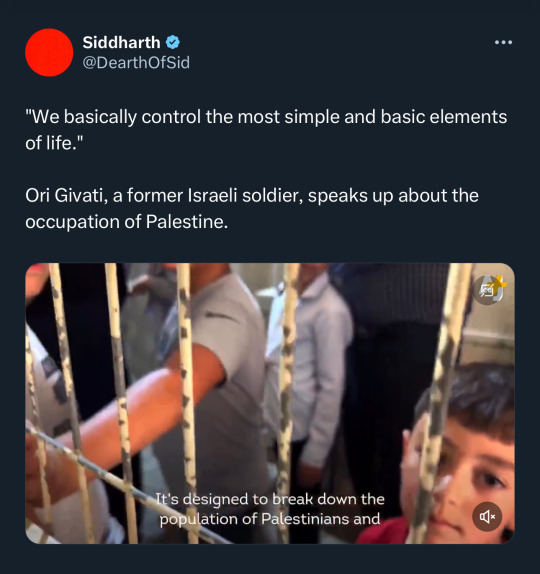
Read that again.
“We basically control the most simple and basic elements of life.” — Ori Givati, former Israeli soldier, speaking up about the occupation of Palestine.
With context, it’s a thousand times more chilling. But even without it, especially if you can relate to being controlled over everything by a bigger but terrible person while growing up, that sentence alone is heartbreaking.
But it shouldn’t take that sentence for people to realize that that’s what it’s been all along since 1948. You just need to open your eyes and see how they, the Palestinians, are treated.
The Palestinians’ water wells were cemented by Israeli soldiers, to stop them from getting clean water. So, forget the Israeli government turning on a simple switch to allow water from their pipes – ‘cause the Palestinians can’t even get fresh water on the only strip of land they have!
How can anyone defend or justify that?
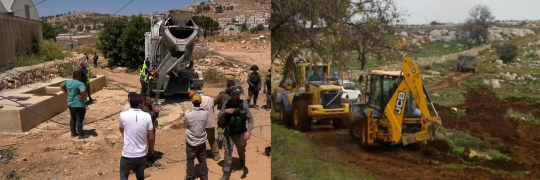
Also, the millions of olive trees that had lived through generations (and it takes years for a new olive tree to produce anything) were destroyed by the Israel occupation since 1948. Now why would Israel destroy olive trees? Olive trees have a very special significance throughout the Middle East. Olive trees are important to Palestinian culture and heritage.
But Israel still continues to burn or destroy agriculture (aside from the bombs destroying it), they never stopped.
Gazan fishermen cannot even fish freely, there have been limits to how far out in the water they could go.
From the words of a Palestinian woman who works in a border school affiliated with the UNRWA (United Nations Relief and Works Agency for Palestine Refugees in the Near East, established in 1949), translated to English:
“Fishermen are hunted at sea and they're falsely accused of getting close to the border. The fishing area keeps shrinking that they now have a tiny area from which they can make a living.”
Full post is here. For heaven’s sake, it takes a year to even get an item that they order from the Internet finally delivered, and even then it’s not a guarantee. The Israeli soldiers won’t give it to the purchaser if it’s dual-use.
Diving goggles are classified as dual-use, so the woman (who wrote the post I just linked) wasn’t able to get them. DIVING GOGGLES!
Where is your humanity?
If you are so desensitized to the gravity of this happening to 2 million people in the year 2023, and if you see all the deaths as just a number, and these numbers are just a statistic to you … I don’t know what I could say to make you understand.
How about the words of a Native American who visited Palestine in the past, and said it reminded him of his home in the U.S reservations? The United States government stole native land hundreds of years ago, and life in reservations are still so bad that this person felt at home in Palestine. THINK ABOUT THAT!
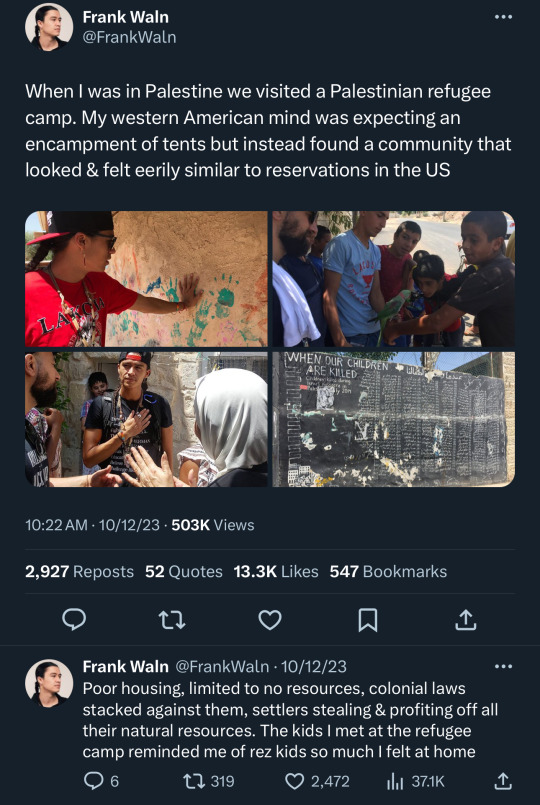
Go ahead, try and tell me Israel isn’t an apartheid that’s even worse than Nazi Germany, or the U.S. genocide of Native Americans.
This occupation has been going on since 1948! Gazans need a permit to enter West Bank (which is often denied to them), and there are checkpoints on every street. And that’s just the tip of the iceberg.
Even when you finish reading this post, it doesn’t showcase half of how much oppression there is.
•
The Israeli government “control the most simple and basic elements of life” there. That was a quote from one former Israeli soldier.
Here’s another former Israeli soldier, speaking up against the occupation, (Eran Efrati):
“I was broken. I felt like I was the terrorist. And my job was literally to scare people so they cannot think about acting against the Israeli settlers.”
“Very early on, I understood that the rights that the Jewish settlers have are not the rights that the Palestinians have.”
“I understood that I cannot touch a Jewish settler if he is attacking a Palestinian.”
“So (these) Jewish settlers that live in Hebron are living under the same rights that I live in, in Jerusalem. But the Palestinians next to them, next house over, next building over, or sometimes next apartment over, lives under my rule, my military rule.”
“And I can do whatever I want with him.”
By the way, this is Stage 3 of the 10 stages of genocide: Discrimination. The Stage 2 is Classification, and Palestinians are a separated group under Israeli law.

Here’s the link to the video.
And a former Israeli Air Force pilot, Yonatan Shapira, said this:
“I was a captain in Israeli Air Force, I was a helicopter pilot and I realized during the 2nd Intifada what Israeli Air Force and Israeli military doing is war crime, terrorizing population of millions of Palestinians.”
“As a child in Israel, you are being brought up in very strong Zionist militaristic education. You don’t know almost anything about Palestine, you don’t know about the Nakba, 1948, you don’t know anything about ongoing oppression.”

Here’s the link to the video.
•
As of October 30, 2023, Israel has wiped out 881 families. Lineages. Bloodlines. This means 30 to 80 persons in EACH FAMILY.
On October 17, that number was only 47 bloodlines.
« Gaza, Oct. 29 (Petra) - The death toll from the war on Gaza has reached 8,005, including 3,324 children, 2,062 women, 460 elderly people, while 1,870 people were reported missing, including 1,020 children, according to the Ministry of Health in Gaza.
The ministry spokesman said the Israeli occupation has carried out 56 massacres in the last several hours, killing 302 Palestinians. Most of the victims were moved to the southern parts of the Gaza Strip, which Israel claims are safe zones.
He added that 116 medical staff were killed, 25 ambulances were destroyed, and 57 health facilities were targeted, pointing out that 881 families were lost as a result of the occupation's purposeful targeting of them. »
And if you don’t believe these numbers, because you’d rather believe Israel – guess what? Israel is keeping score, and published it on their Channel 14 news channel with rising numbers. Israel are genocidal maniacs. It’s not my fault you refuse to believe what your eyes can see.
UPDATE
As of November 25 of 2023, the number of deaths reached 20,000. The number of children among them are 8,176.
•
“We must learn that passively to accept an unjust system is to cooperate with that system, and thereby to become a participant in its evil.” — Martin Luther King, Jr.
“Nice people made the best Nazis. My mom grew up next to them. They got along, refused to make waves, looked the other way when things got ugly and focused on happier things than “politics.” They were lovely people who turned their heads as their neighbors were dragged away. You know who weren’t nice people? Resisters.” — Naomi Shulman
•
•
•
And along with Israel bombing the Palestinians using the internationally-banned white phosphorus—!
It is so violent in its destruction, and, I repeat, it is prohibited under international law! Of course, you’d think that violating the Geneva Convention would result in heavy consequences, but imperialist governments not caring and getting away with anything is a different topic.

It is so wicked, I can’t—
Even if you don’t care about a massive loss of human life, the phosphorus effect on agricultural lands are devastating and lasts for years. It still makes people sick and nauseous with no apparent signs of injury on the plants.
And all the mushroom clouds after those CONSTANT bombs drop on Gaza!
Even if you don’t care about the loss of human life, do you have a speck of humanity in you to care about all the pollution? At the very least?
•
How many times does the Israeli government have to be caught lying or admit to lying, before you realize they can never be trusted because they’re liars? They have a long history of it, too!
OPEN YOUR EYES!


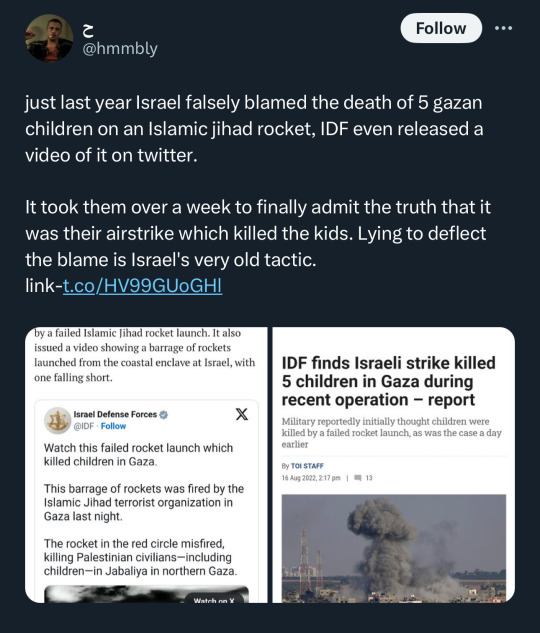
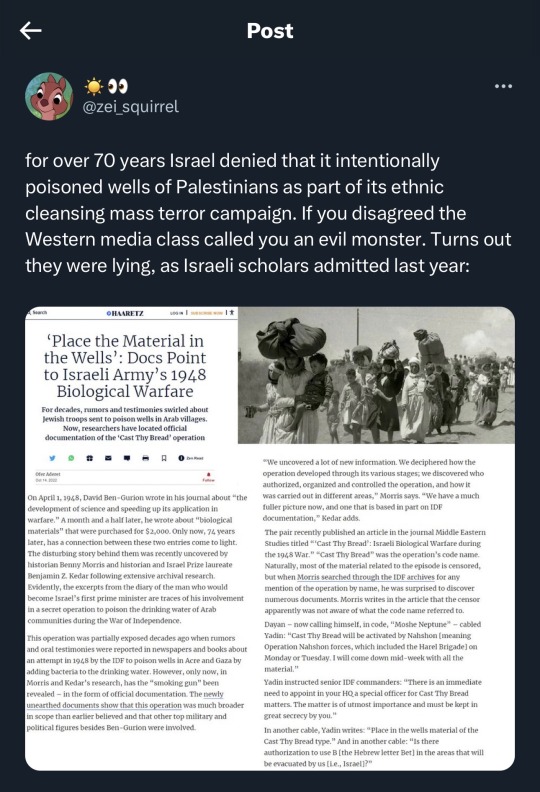
OPEN YOUR EYES!
When the people had a funeral for American-Palestinian journalist Shireen Abu Akleh, the Israeli police kicked and beat the mourners who were carrying the casket.
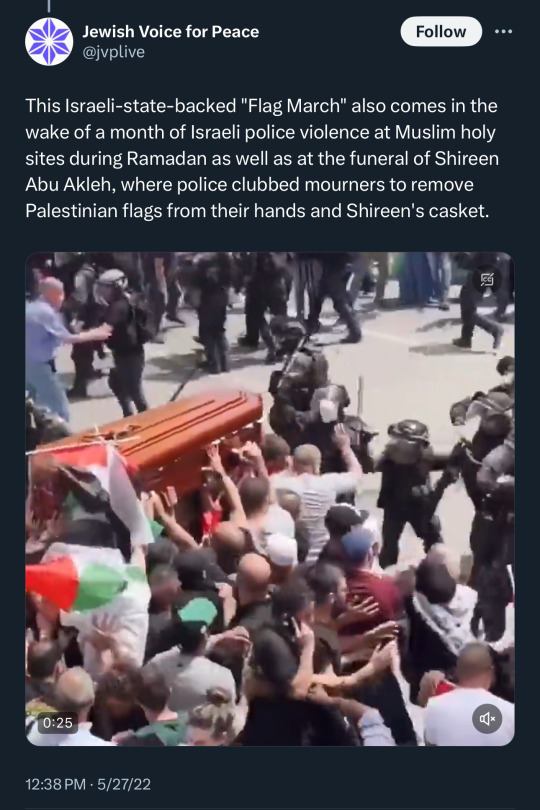
Is it any wonder that there are former Israeli soldiers and pilots who stopped supporting their government because they felt like terrorists, and realized it is Israel who are the terrorists?
Look at this!


•
It is also NEVER a normal time to say “I’m a little bit fascist,” whether it’s 2000 or 2023…but the video in the tweet below is from 2009. This is an Israeli woman saying, “I’m a little bit fascist.”
Imagine thinking this is normal to talk that way. Imagine thinking fascism is, in any way, good or beneficial.
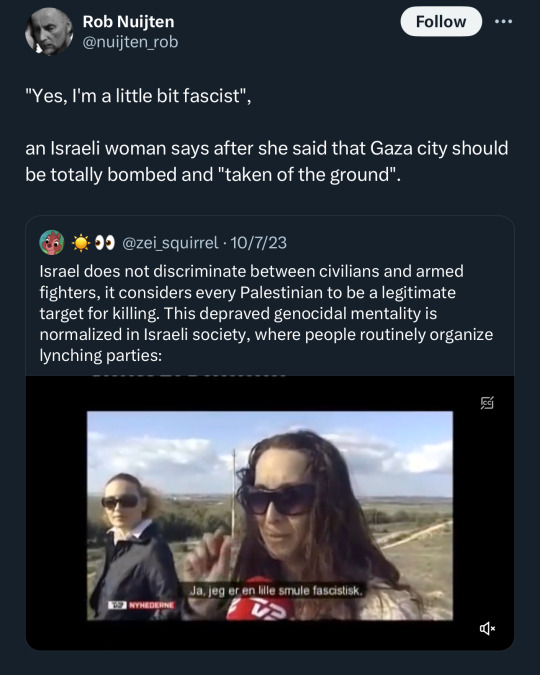
•
The Palestinians in the Gaza Strip do not have basic human rights.
If you value having your human rights, do not turn a blind eye to Palestine.
Their access to the outside world, via WiFi and the Internet, is the one and only way they can spread awareness of what’s going on.
No government should have the power to turn off water and cut electricity and telecommunications.
Collective punishment is a war crime under international law, a crime on humanity that could easily be done to you. You think you’re safe in your country? Every protest and demonstration or march (on any topic, really) is met with the same brutal police treatment. What’s to stop them from going all out, the moment they get the government’s green light? I remember military vehicles coming out in force during the BLM protests. Many people are permanently blind and/or disabled from the tear gassing and the rubber bullets.
•
You cannot justify indiscriminate bombing on a densely populated SMALL area. It’s never right, but think about this…
The Gaza Strip is 139 square miles.
Detroit, Michigan is also 139 square miles.
Detroit only has less than six hundred thousand people in their population. The Gaza Strip has two MILLION.
Religious buildings, universities, hospitals … bombed, all under the excuse that “terrorists” were hiding there.
The same exact excuse Israel used to justify bombing a school in Egypt in 1970, it is not new and not exclusive to Gaza. They always use the same tactics.
•
•
•
What I’m sharing here is pretty much everything I’ve shared (and then some) about the occupation and genocide against Palestinians. So, pardon me if it’s not cohesive, because it’s not really meant to be. I shared most of this just one time with somebody, and I still got hit back by that heartless lunatic threatening me to watch and “enjoy Israeli retribution.”
It’s bad enough seeing it in the comment sections on YouTube or Twitter; it’s even more mind-boggling to have it spoken in direct response to me in my attempt to appeal to what little speck of humanity they have left, so I don’t make a habit of speaking up.
•
•
Palestinians are Arabs. Arabs are Semites.
If, for some asinine reason, you support Israel on the genocide they’re committing right now against Gaza, and you still want to call me an anti-Semite … then you should know that a former Israeli minister of education said (nonchalantly) back in 2002 that they always use that label as a trick on anyone who criticizes the Israeli government.
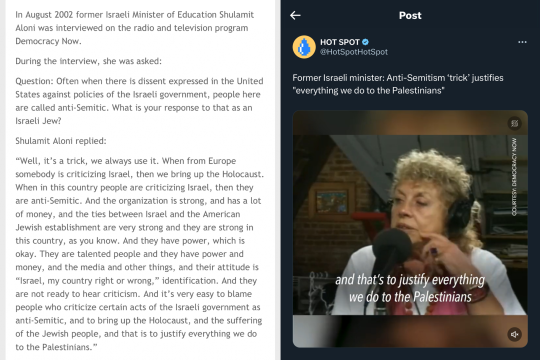
And a former Israeli Mossad agent, in 1995, said that labeling someone an anti-Semite is one of the ways he silenced critics. They know you’re not an anti-Semite, but they will label you as such to discredit you.
Victor Ostrovsky: « But I know what they do ‘cause I used to ask them to do it. When I was in the Mossad and we had a guy that gave us problems in the U.S., and he was speaking out and he was talking like people talk once and said, “Israel is bombing Lebanon with cluster bombs,” we say, “Hey, who’s that guy?” you know? ‘Pete Macockey,’ we used to call him. Yeah, which is Pete the Cockroach, ‘cause he makes a lot of noise and you can’t get rid of him. So, what you do is you get in touch with a guy in the station in New York or in the station in Washington and tell the guys in B’nai B’rith to label him. And, of course, the campaign starts, and before you know it, the guy is labeled. And he’s ‘an anti-Semite’ because that’s what we say he is. It shames me as a Jew to tell you that. But that’s the fact and it’s wrong. »

It SHAMED him as a Jew to say that this is what his government does. This is what Israel does!
The same thing happened in Nazi Germany – it was illegal to even mock Adolf Hitler, or talk badly about the Nazi regime. It’s the same thing regarding CPC, Chinese citizens will have their online posts deleted if they criticize China. And it’s the same with North Korea, it’s actually worse than China – they cannot even consume foreign entertainment if it’s not sanctioned by their government.
If you criticize Israel, their government will silence you by slapping on the “anti-Semitic” label onto you.
As Shulamit Aloni said, “It’s a trick, we always use it.” Thank you for exposing yourselves!
If you’ve reached all the way down to this part of the post, and anything I’ve typed out hasn’t moved you emotionally at all, you should stop calling yourself pro-climate and pro-life.
And look!
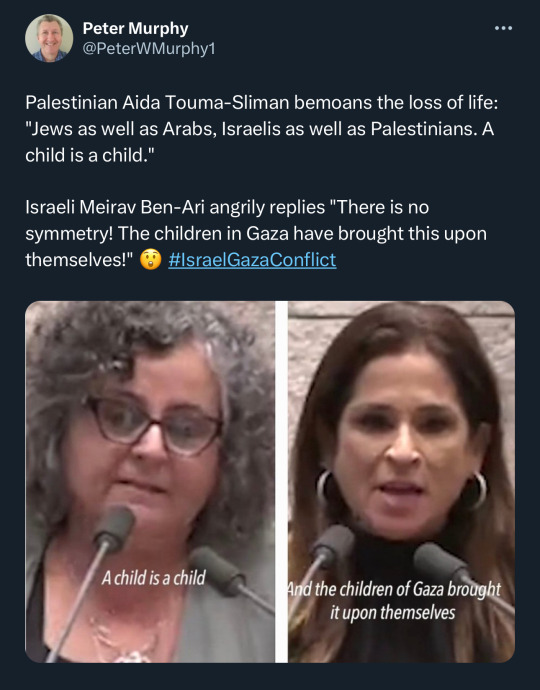

It’s there for all to see.
We don’t even have to expose Israel’s black hearts, they’re doing that all on their own.
We literally just have to point this out. The rest is up to you.
Imagine Russians doing this about Ukrainians!

Is this who you want to defend? “God’s chosen people” mocking cultural attire, comparing Palestinians to dogs, dehumanizing them, degrading their deaths, laughing at mothers losing their children.
Is this the hill you want to die on? IS THIS YOU?!
The depravity!
•
•
•
“Words and terminology are crucial," said Hussam Zomlot, the Palestinian Head of Mission in the United Kingdom. "From the beginning, Israel wanted to link the Palestinian people to Hamas. And then they linked Hamas to ISIS. That’s linking ISIS to what? The Palestinians.”
Article by Lemma Shehadi • October 17, 2023
———
[A thread by Dr_MianUmair1 on Twitter]
There seems to be a lot of confusion regarding the distinction between Hamas and ISIS. It is important to clarify that these are two distinct entities with different goals, ideologies, and methods.
Hamas is a Palestinian political and military organization that was established in 1987. Its primary objective is the liberation of Palestine, Hamas engages in political and social activities, as well as armed resistance against Israeli occupation.
On the other hand, ISIS (Islamic State of Iraq and Syria) is a radical Islamist extremist group that emerged in the early 2000s. Their goal was to establish a caliphate in Iraq and Syria, imposing their version of Sharia law and carrying out acts of terrorism worldwide.
While both organizations have been classified as terrorist groups by various countries, it is crucial to note that their motivations, strategies, and geographical focuses are vastly different.
Hamas primarily operates in the Palestinian territories, with a particular focus on the Gaza Strip; while ISIS was primarily active in Iraq and Syria, although their influence has significantly diminished in recent years.
Hamas, despite being a designated terrorist organization by some countries, also has a political wing that participates in democratic processes and provides social services to the Palestinian people (A reason why they love Hamas)
In conclusion, Hamas and ISIS may share the label of "terrorist organization," but they are not the same. Understanding their distinctions is essential for informed discussions about the region. 🌍🤝
———
But, now, what if I told you that Israel (and the U.S., “indirectly and directly”) created Hamas?
U.S. Congressman, Ron Paul, in 2009:
“If you look at the history, you’ll find out that Hamas was encouraged and really started by Israel because they wanted Hamas to counteract Yassir Arafat [chairman of the Palestine Liberation Organization, PLO].”
“So, then, we as Americans say, ‘Well, we have such a good system, we’re going to impose this on the world, we’re gonna invade Iraq and teach people how to be democrats.’ We want free elections, so we encourage the Palestinians to have a free election, they do and they elect Hamas.”
“So, we [the United States] first indirectly and directly, through Israel, help establish Hamas, then we have election that Hamas becomes dominant, so we have to kill them.”
Hmm, so Israel-U.S help establish Hamas, playing them against each other until they get their dominance, just so Israel can justify killing Hamas and every single Palestinian? That, coupled with the former Israeli politician saying that they slap the ‘antisemitism’ label on critics to justify killing the Palestinians? Wow, Israel and the U.S. sure do sound like the evil villains here. It almost sounds like…they always planned to commit genocide! Look at my shocked face > ö
But anyway…
•
Painting Hamas with the ISIS brush has implications for how Israel is expected to fight its war with the Palestinian militant group, experts told The National.
“There is a danger in comparing Hamas to ISIS, which can indirectly legitimise disproportionate use of violence on civilians in Gaza, under the pretence of fighting terrorism,” Ms Khatib said.
Experts highlighted the US-led coalition’s war with ISIS in 2014, during which Iraqi and Syrian cities were razed, killing up to 11,000 civilians in Iraq alone and displacing hundreds of thousands more.
“The US government labelled its campaign in Syria and Iraq as 'a campaign of annihilation', so for Secretary Austin to be suggesting Hamas is the same or worse is doing little more than encouraging Israel to assume a similarly brutal approach in Gaza,” said Charles Lister, director of the US-based Middle East Institute’s Syria programme.
The 6,000 bombs dropped on Gaza in the first six days, as claimed by the Israeli air force, had already exceeded the rate of US bombing of ISIS in Syria and Iraq, which averaged 2,500 per month across 46,000 square miles," he added.
NOTE: This article is from October 17. There, Israel wiped out 47 bloodlines (which means 30 to 80 persons EACH family name.) As of October 30, 2023, that number has risen to 881 families taken off the civilian registry. Whole bloodlines, gone.
As of November 25? 20,000 were killed in total. And 8,176 of them are children.
Don’t talk to me if you support Israel, even after everything you’ve read in this post.
FREE PALESTINE 🇵🇸
A focus on fighting terror would also obscure the “root causes” of the conflict.
“The narrative will be totally overwhelmed by terrorism and security. Whenever these things happen between Israel and Palestine, there is never a root discussion of settler colonialism, of occupation or dispossession,” said Chris Gunness, a former spokesman for the UN’s agency for Palestinian refugees.
———
This BBC documentary takes place in 1982, years before Hamas existed. What was Israel’s excuse, then, for their massacre of Palestinians and Lebanese Shias that took place after this?
Israel bombs Lebanon and Syria. Two completely different countries. There are no Hamas there. What’s the excuse?
•
They’ve committed all the stages of genocide, and all you have to do is open your eyes.
Israel are the terrorists!
A giant with all the advantages of their size (and a world power like the U.S, the biggest, backing them and funding them) is NOT the victim.
Israel isn’t even scared of the United Nations. Think about that! Nearly five dozen U.N staff members, as of October 30, were killed in Gaza because of Israel’s bombs. And all the U.N can do is hold a service for their colleagues??? Acting as if this is normal?
•
This is Palestine, BEFORE the Israeli occupation:

Where is your humanity?
Resistance does not happen in a vacuum.
Support Palestinians. Save Gaza. Free Palestine!
You don’t need to be religious. You don’t need to be a Muslim, Christian, or Jew. You just have to be human.
#palestine#genocide#free palestine#israel is a terrorist state#israel is an apartheid state#israel is committing genocide#gaza strip#palestinians#save gaza#spread awareness#ceasefire#white phosphorus#nearly a thousand lineages were wiped out by Israeli bombs which are 30 to 80 persons per family line#this is not a war IT IS GENOCIDE#free gaza#i stand with palestine#anti imperialism#save palestine#long post
18 notes
·
View notes